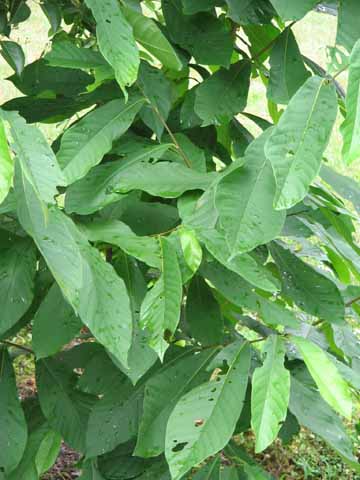Plants and People Project
Pawpaw - Asimina triloba
Native Americans enjoyed the delicious custard like flesh of this small tree's fruit. It is often compared to tropical fruits. Pawpaw fruit ripens during a four-week period between mid August and into October
"Eastern Native American tribes cultivated the Pawpaw for its fruit, spreading the tree from the Ohio River Valley south to Florida by planting seeds as they traveled. The fruits were mashed into cakes and then dried for use by hunters as portable food. The fibrous inner bark was used as cord to string fish, a practice adopted by the colonists." Hiker's Notebook
The seeds are insecticidal. Indians dried and powdered them. They applied them to children's heads to control lice. Peterson's Medicinal Plants.
The leaves are also insecticidal. The narrow leaves can be nearly a foot long.
Caution - Touching the leaves gives some people a rash.
Colonists cultivated pawpaws. In fact, they were grown commercially in the US until around WWII. Now they are typically only found in the wild.
Kentucky State University scientists are currently working to restore and improve the cultivation if the Pawpaw.
"Aromas may be used commercially in cosmetics and skin products. Pawpaw plants produce natural compounds (annonaceous acetogenins) in leaf, bark and twig tissues, that possess both highly anti-tumor and pesticidal properties. Current research by Dr. Jerry McLaughlin at Purdue University suggests that a potentially lucrative industry, based simply on production of plant biomass, could develop for production of anti-cancer drugs (pending F.D.A. approval) and natural (botanical) pesticides." Pawpaw fact sheet from Purdue University
In addition to seeds, pawpaws spread by their roots. Take care to plant them in an area you are willing to have lots of trees. They have become invasive in my vegetable garden. Every year I must dig out the saplings.
Many mammals and birds enjoy Pawpaw fruit, too. Down in the Pawpaw Patch
Pawpaw fruits are rich in vitamins and minerals
The Pawpaw is the host plant for the Zebra Swallowtail Butterfly caterpillar.
Pawpaw NPR video on CBS Sunday Morning
Play What tree is it? off site
Identification and other facts / More facts
Pawpaw


Pawpaw flowers

The flowers hang down facing like bells on the branch.

Mature Pawpaw fruit on tree in September
DISCLAIMER: These pages are presented solely as a source of INFORMATION and ENTERTAINMENT. No claims are made for the efficacy of any herb nor for any historical herbal treatment. In no way can the information provided here take the place of the standard, legal, medical practice of any country. Additionally, some of these plants are extremely toxic and should be used only by licensed professionals who have the means to process them properly into appropriate pharmaceuticals. One final note: many plants were used for a wide range of illnesses in the past. Be aware that many of the historical uses have proven to be ineffective for the problems to which they were applied.